MARKETING
What It Is & How to Get Started

Media buying is an important process for almost any business, with paid online advertising, TV advertising, audio advertising, out-of-home advertising and more being crucial aspects of many multichannel marketing strategies. However, online and offline advertising are far from simple, and digital in particular is getting more challenging every year as a variety of platforms struggle to balance effective targeting with privacy considerations.
In this guide, we’ll explore how media buying works today, its importance, how to overcome challenges, and trends to watch out for.
What Is Media Buying?
Media buying refers to the act of procuring ad space or time. Digital media buying occurs when buyers purchase ad space via online ad networks, social media platforms, or directly from website or podcast owners. Offline media buying occurs when buyers purchase ad space or time with television networks, radio stations, or through out-of-home (OOH), including billboards and digital signage ads.
Media buyers will work to manage advertising budgets and optimize ad performance. They must consider factors such as where the target audience is likely to be, the cost of ads of various placements, and how often ads should run. Typically, media buyers are part of the overall marketing team and work closely with other marketing staff.
Media Buying vs. Media Planning
Media buying is different from media planning, although the same people may be involved in both. Discover a bit more about these two critical advertising tasks and how they go hand-in-hand below.
Media Planning
Media planning comes before media buying. The role of a media planner is to conduct research and lay out a strategic framework that the media buyer can bring to life. Some components of a strong media plan include:
- Goals that align the media strategy with the business objectives
- Definition of KPIs to help measure the performance of media campaigns
- Information about the audience to help the media buyer better target ad campaigns
- Budgets for campaigns to help the buyer keep things within scope
- Information about what channel and partner mix is likely to best support strong campaign performance
It’s important to note that media planning is not a task that takes place in an advertising vacuum. Media planners may also plan other types of marketing, or work closely with teams that are handling social media, email, and content marketing. It’s critical that ad campaigns work seamlessly with these other channels to support overall marketing success.
Media Buying
Once a plan is created, media buyers use various tools to implement the plan. Media buyers are responsible for reviewing the insights provided and boundaries set by the media plan so they know what type of media mix to seek, what audiences the ads are meant to connect with, and how much marketing spend is allowed for each campaign. Much of the value they bring comes through their awareness of the media marketplace, access to unique opportunities, and their skilled negotiation, helping to stretch each advertising dollar for the greatest impact.
Once they understand the plan, media buyers use varied processes to execute it, including leveraging programmatic buys, direct buys, or both. Programmatic and direct buying are covered in greater detail in the section on different media buying methods below.
Why Is Media Buying Important?
The act of media buying is essential if you want to advertise, and advertising is critical for most businesses today. It can be difficult to drive enough organic traffic or engagement to sustain revenue without some advertising efforts. That’s even more true for startups and new product launches, because it can take months for organic efforts such as SEO to have a real impact on traffic and visibility.
Some key reasons to invest in a more strategic media buying effort include:
More informed negotiations
Experienced media buyers keep up with current trends in the industry and are accustomed to leveraging negotiation techniques to get the best deal possible. They will be able to get networks or publishers to agree to added value to enhance the ROI of ad spend, and execute first-to-market opportunities that truly help a brand stand out from the clutter.
Ability to optimize ad placements
Experienced media buyers have existing relationships and connections within the industry that can help them in securing strong ad placement, and in optimizing campaigns as they evolve. Having deep connections with network partners is critical in continuing to collaborate on what is working (or not) as brands look to hit their KPIs.
Options for cross-channel integrated campaigns
It’s important not to think of your media buys in a silo, instead focusing on the right mix to properly support and amplify each effort.
Example: Let’s assume your brand will be airing their first prime time commercial on Black Friday. You’ve put a lot of time, research and money into producing a TV commercial that captures your brand energy, and it will ideally serve as an introduction of your brand to a whole new audience. You’ve also focused on a new product line you’re launching in the ad, which will be appealing to new and existing customers. Simply put—you’ve put a lot into this commercial, and you want to be sure you get the most from your investment.
Now, imagine your total media buy for this holiday launch included only the commercial ad spot—an expensive one-and-done that you were hoping would be impactful enough to carry the whole campaign. That’s neither realistic nor the best use of your money.
In an integrated media buy, that same messaging would be seen before, during, and after the commercial airs. This might include pre-air social media promotion efforts, encouraging folks to tune into the commercial for an exciting brand announcement. It can also include additional linear and/or Streaming TV buys that run surrounding the airing to build familiarity amongst the audience. Whatever advertising channels you have available can be considered in the media buy from the outset to ensure you have proper supporting media planned and budgeted for.
“For tentpole events especially, it’s important to leverage supporting media on the platform itself, in addition to amplifying the message across all other marketing channels. Getting the message in front of the largest number of people possible is only part of the equation; repeating that same message across other platforms with the right reach and frequency helps make sure that big impression sticks.”
— Stefanos Metaxas, EVP, Client Strategy & Analytics, Streaming+ at Tinuiti
Quality Creative Matters
Showing up in the right places at the right time for the right audiences is important, but it’s not everything. How you show up matters just as much.
We asked Stefanos Metaxas, EVP of Client Strategy & Analytics, Streaming+ at Tinuiti, to provide insight into what our creative process typically looks like…
“Our creative process varies depending on a few key factors. For example, the steps we take for a client who has signed on for our creative services will be different from those we’d take if a client was providing creative work their in-house team produced.
If a client provides us with ready creative, we review it for any straightforward optimization opportunities. We’ll often provide feedback to determine if small edits are possible—such as adding an end card, a logo, or a call to action.
If a client has in-process creative, one of our team members can provide a light review, taking a closer look at the storyboards to ensure everything is buttoned up. Occasionally, we might also submit the creative for approval or prior oversight from the networks themselves if the brand is promoting anything that might impact the networks’ internal review processes. This is rarely required, but a step we proactively take for select industries to ensure our campaigns launch without a hitch when the time comes.
If a brand is looking for a true creative partner to guide them through every step of the process, we’ve got you covered with our creative services arm.”
How Different Media Buying Methods Work
Media buying might sound like a pretty specific task, but it actually covers a wide range of methods. Some businesses concentrate on programmatic media buying, for example, while others focus more heavily on direct buying and offline media. At Tinuiti we employ a mix of all methods, giving us flexibility in aligning media plans with clients’ business goals.
Programmatic vs. Direct Buys
Programmatic buys are orchestrated with help from automated technical tools. Artificial intelligence is used to create programmatic advertising buying decisions that conduct real-time bidding at a pace and scale that is impossible to maintain manually.
Typically, these processes are run based on algorithms that match ad opportunities to campaign profiles set up by your media buyers. The better media teams are at dialing in these profiles and the more clarity provided on the KPIs, the better the outcome.
In contrast, direct buying refers to manually negotiated ad contracts with specific media partners or programs.
When you use something like Google Ads, you’re typically engaging in programmatic buying. If you negotiate ad space with a website owner directly or pay to sponsor an individual podcast, that would be direct buying.
Full-Service vs. Self-Service
When you’re working to set up media buying for your business, you’ll first decide between self-service and full-service buying. Full-service media buying—commonly referred to as managed-service—is offered by digital ad and performance marketing agencies like Tinuiti.
With self-service media buying options, you handle all the work to implement and execute your plan. That includes uploading the necessary information to ad networks and making needed adjustments to campaigns to optimize performance.
Full-service media buying
In a full-service arrangement, a dedicated media buying team negotiates directly with the publishers on your behalf, using their scale to get you better rates than you might going it alone. A good partner will work with you to create the media plan, shoot and edit the right creative, and align (and place buys for) a media plan with your specific goals in mind.
“If you want to go it alone, you can buy whatever network you want, but is it going to align with who you’re trying to reach, when you’re trying to reach them, and actually result in a conversion and/or an increase in brand lift? That should be determined by someone who is an expert in the field. It takes a lot of experience to do so, in addition to our proprietary tools that allow us to design media plans around clients’ goals.”
— Stefanos Metaxas, EVP, Client Strategy & Analytics, Streaming+ at Tinuiti
You’ll also want to explore what your partner can offer regarding measurement and reporting. Not every agency offers measurement, and among those that do, some are using a third-party measurement tool that isn’t really built for this particular application.
At Tinuiti, our measurement capabilities—and the resultant reporting and insights they provide—play a pivotal role in the data-driven media buying strategies we execute for our clients.
Our teams provide robust measurement that helps you understand how the media you’re running impacts your business. This measurement helps inform future media buys, so we’re able to constantly refine your campaign for maximum effectiveness and efficiency.
Offline Media Buying
Traditional media outlets are a valuable advertising option for many businesses, often working in tandem with online buys. These include television and radio advertising as well as out-of-home (OOH) media, such as billboards and signs at transit stations. To maximize ROI for these ad formats, media teams must be creative and well-informed about the needs and habits of their target audiences.
TV
Our definition of TV is evolving as most people typically watch both linear TV and Streaming TV on the largest screen in the house—often, in the living room. If you’re working with the right partner, they will work with your budget to plan a media buy that will help you achieve your goals. Agencies like Tinuiti do have campaign minimums to ensure a clear read on results, but both linear TV advertising and Streaming TV advertising may be more affordable than you think—particularly for campaigns designed to test the performance waters.
Radio Networks
Radio advertising is an established advertising medium that enables you to reach wide and varied audiences while they work, commute, exercise, cook and clean, and more.
Radio advertising is broadly broken into two categories—terrestrial radio (traditional) ads and Streaming radio ads. While traditional radio advertising has its benefits, one of its biggest drawbacks is the difficulty in measuring its performance.
At Tinuiti, we typically recommend digital audio advertising as an alternative to terrestrial radio. For Streaming radio ads, we are able to track KPI outcomes, and use those learnings to continually improve our clients’ campaigns.
“Streaming audio is very measurable. Similarly to Streaming video, we use data to measure the impact of impressions across the audio landscape, including podcasts, without relying on HDYH surveys and promo codes.”
— Stefanos Metaxas, EVP, Client Strategy & Analytics, Streaming+ at Tinuiti
Out-of-Home Advertising (OOH)
Out-of-home advertising options include an increasingly wide variety of methods and tactics, including traditional billboards and digital signs, transit advertising, experiential advertising, and guerilla marketing. When buying this type of media, it’s important to consider the optimal placement for your message and audience.
For example, if you can quickly convey a relevant message to professional commuters on their way to work via the freeway, a billboard might be ideal. However, if your message is more complex and takes a bit more time to digest, you might fare better with a digital sign at a bus stop or metro station.
How the Media Buying Process Works
Your media buying process must work with your business and marketing goals and integrate well with other processes, such as sales and customer service. But there are some steps in media planning and media buying that every organization should consider.
Set Goals & KPIs
Start by understanding your primary goals, and how you’ll measure performance. This includes considering:
- Overall business goals. Ensure you have a strategic understanding of the business, including short- and long-term goals. Marketing and advertising must support these goals, and the paths you take with media buying may be quite different if you’re in a viral growth period than they would be if you’re trying to sustain existing revenue, for example.
- Overall marketing and advertising goals. Next, take some time to understand big-picture marketing goals. Remember that ad campaigns don’t operate on their own; they must be planned and implemented to support the greater marketing strategy. Discuss the expectations for marketing and advertising overall, and what the business aims to accomplish. Common goals include increased brand awareness, generating revenue, or supporting the sales funnel.
- Specific campaign goals. Now get into the nitty-gritty and set measurable goals for every campaign. If you haven’t determined which metrics to capture, you won’t be able to compare campaign efforts to goals or to past performance.
Define Your Target Audience
Every ad campaign should have a well-defined target audience that you’re trying to elicit some kind of response from, whether that’s making them aware of your brand or buying something. Insights into the desired audience help the media buyer optimize bidding strategies to support campaign performance.
Sometimes, your entire target audience is an appropriate audience for an ad campaign. It’s more likely, however, that a segment within the larger set is the best audience for a specific ad, offer, or product. For example, an online bookstore running an ad campaign centered on summer reading would want to target an audience composed of people including parents, grandparents, and teachers.
Research Media Channels
You could simply throw all your ad budget at a single network and call it a day. However, if hitting your goals was that simple, media planners and buyers wouldn’t exist! Instead, it’s important to research a wide variety of media channels to determine how they can align with the target audience and goals for a given ad campaign.
At Tinuiti, our strategic planning team uses tools to determine the optimal mix of channels to reach a specific audience, as well as the budget we should allocate to those channels.
Media channels can include, but aren’t limited to:
- Search, including Google and Bing
- Email, which lets you advertise in emails sent through email marketing networks
- Social media, including TikTok, Instagram, and Facebook
- Television, including cable and broadcast networks as well as OTT services like Netflix and Hulu
- Audio, including local radio as well as streaming services like Pandora, and podcasts
- Print, including newspapers and magazines
- Direct mail, such as ValPack
Determine Your Required Budget
It’s important to begin by defining your audience and determining where that audience consumes media before setting your budget; these two elements greatly impact how much you’ll need to spend to reach the right audiences in the right locations, and at the right frequency.
Send Requests for Proposals (RFPs) – Self-Service
If you choose to take the self-service route, your process should include sending RFPs to glean more information about ad opportunities. It’s important to be specific in your RFP and ask for the data you need to make the best possible decisions with your ad budget. When you ask for specific information consistently across all your RFPs, you also build a data bank of apples-to-apples info that can be used to make better media buying decisions.
Some information to ask for in an RFP includes:
- Available ad inventory
- Price, including net media costs
- Ad specs
If you’re working with an experienced, full-service partner like Tinuiti, we would not recommend or require you RFP networks on your own. Our media buying team is already fully versed in the available offerings, and in some cases have pre-negotiated preferential pricing. This can stretch your campaign budget further than the rates you’d get independently might allow for.
Submit Insertion Orders (IO)
Only applicable to direct deals, this is the agreement between you and the publisher about your ad. At Tinuiti, we have a sophisticated interface that generates, sends, and maintains IOs. Because you need an IO for each ad deal, we recommend working from templates to make the IO process efficient and accurate if you’ll be going the self-service route.
Each IO must contain the terms and conditions of the agreement. Large publishers, vendors, and brands may want their terms used for the IO, but there is also often some room for negotiation. An experienced media buyer knows when negotiation is possible and can use tactics to get more favorable terms and conditions for the advertiser.
Launch Your Campaign
Once all your creative and paperwork is in order, you’re ready to launch your campaign. This can take mere minutes, as with small ad campaigns on social media, or days to weeks, as is common with out-of-home advertising.
Measure & Optimize Live Campaigns
Once campaigns go live, the media team’s job is not done. It’s important to regularly measure the performance of campaigns and optimize them when and where possible to keep up with changing conditions, or in response to insights.
Many digital ads can be changed quickly and easily, with updates taking effect within hours if not minutes. Historically, the insights necessary to make these in-flight optimizations haven’t been available for television advertising. Brands would launch a two-month ad campaign and have to wait until it was finished to have any real insights into its performance.
At Tinuiti, our robust measurement capabilities unlock and enable in-flight optimizations that can be quickly implemented, even in traditionally inflexible channels like linear TV.
Review & Analyze the Campaign’s Final Spend
Once the campaign is over, conduct a debriefing. Analyze how much you spent and what results were driven by that spend. Ask the team whether something could have been done differently and better and what lessons were learned from the campaign. If something worked really well, note it for future efforts.
Overcoming Media Buying Challenges
Media buying is a complex process that can come with any number of challenges. If the media plan isn’t well-thought-out, for example, it can leave the buyer spinning their wheels. Or if the audience isn’t clearly defined, the buyer’s efforts are not likely to lead to great success. Here are a few other common media buying challenges.
Measurement
As previously mentioned — more than once, because it’s that important — you must be able to accurately measure the performance of your ad campaigns. Without the right metrics, you can’t determine what is working and what isn’t. That means you can’t make data-backed decisions to improve ad performance in the future or justify your ad spend. Note that we are defining “performance” as the ability of a campaign to impact KPIs that are important to a brand, whether that is brand awareness or conversions for example. Even in a pure brand campaign, you need to maintain some bottom-of-funnel guardrails to keep the business on track, so measurement is important no matter what your ultimate goal is.
Data-driven attribution that ties conversions and revenue to specific ad campaigns has historically been a challenge in the clickless TV space in particular. As a performance-oriented marketing agency, overcoming that challenge was crucial to our continued success. At Tinuiti, there is no reporting black box. Our robust measurement and reporting helps fuel campaign efficiency and performance while providing our clients with the detailed insights they need.
Ongoing Optimization
The ability to adjust live campaigns in real-time gives you increased potential power over performance; that’s especially true when you have consistent, accurate measurement.
Thanks to our team’s detailed and actionable campaign insights, we are able to regularly optimize campaigns based on up-to-date information. There is no endless loop of “waiting for a campaign to end” to see how it performed, and “waiting for next time” to try something different; we are always measuring and appropriately optimizing.
Ad Fraud
Client hijacking is a form of ad fraud that involves a cybercriminal redirecting clicks on your ad to a different ad. In essence, the scammer steals the click, but you still pay for it.
As a media buyer, it’s important to be aware of this and other issues, and understand the signs that it might be happening to your ads. If you’re eating through your budget, for example, but you don’t see the traffic that the clicks seem to indicate, your ad might have been targeted. You can contact the ad network to report the issue.
Brand Safety
Programmatic advertising presents a challenge for brand safety. If your ads are associated with the wrong words or context by ad algorithms, you might end up with a brand reputation issue. For example, a children’s toy brand doesn’t want its ads showing up next to violent content.
Media buyers can reduce some of these issues with custom keyword lists and negative keywords. You do need to take care with these tactics, though, because if you’re too cautious, you can unnecessarily limit your advertising opportunities.
Examples of Media Buying Platforms
There are many media buying platforms to choose from, and when you’re buying ads to support various campaigns, you may need to work with more than one. We encourage you to put some time into researching which options work best for your particular business, with some summaries for popular platforms below to get you started…
Proprietary Tools
Tinuiti’s product offering includes tools with which our teams can plan, execute, and monitor media buys across a variety of landscapes such as linear TV, OTT, and digital audio. This synthesizes what can be an enormous amount of individual campaigns into a single platform for consistency and ease of use by our buyers, and for viewing performance.
We transact in this platform whether we are issuing IOs directly to partners, or buying these channels programmatically. We have also built and continue to iterate on our internal tools to “talk” to other platforms in the digital marketplace, like a demand side platform (DSP) for programmatic buying.
Google Display & Video 360
Google Display and Video 360 provides end-to-end management for display and video ads on the Google network. As the arguable king of digital advertising networks, Google has a lot to offer, including collaborative workflows and a truly amazing amount of data.
You can customize dashboards to keep an eye on your media efforts and involve your entire media team — from creative to analytics. You can also streamline the audience management process, because your audience insights are accessible in a single location and support all types of ads.
Finally, Google tools are backed by a high level of automation options powered by Google technology, making for easy-to-scale ad efforts.
The Trade Desk
The Trade Desk is a media buying platform that helps you advertise to the right audiences, whether they’re local or on the other side of the globe.
You can use this platform to plan future campaigns, implement and optimize current campaigns, and measure your success. Media buyers who use this platform get access to more than their own data. Premium partners can make use of data from around 2 million segments from other partners, which can help you optimize ads even if your business or product line is very new.
The Trade Desk also has in-house data scientists and engineers that can help develop custom solutions and approaches to advertising.
Amazon DSP
Amazon DSP is a demand-side platform that provides access to ad opportunities on Amazon as well as other locations online. This platform provides exclusive access to Amazon ad opportunities, which can be critical for those with an Amazon Store or products on the platform.
However, you don’t have to sell products on Amazon to use this platform. Amazon DSP also comes in self-service and managed-service options, so you can get the right level of service for your business needs.
Amazon also offers a lot of education and training, providing a path for almost anyone to gain success with this DSP. Agencies and other professionals may want to take one of Amazon’s DSP certification courses to demonstrate their knowledge.
Criteo
Criteo specializes in connecting advertisers with retailers and publishers. Specifically, it works with businesses such as Shopify and Best Buy, and it helps get your ads in front of retail customers who are primed to make purchases.
A particular strength of this platform is that it relies primarily on first-party data to support automated ad decisions. This helps reduce the impact of the crackdown on third-party data on digital advertising.
Adobe Advertising Cloud
Adobe Advertising is an Adobe product that integrates seamlessly with other offerings from the software giant. This might be a good platform to use if you already use Adobe for ad creative or project management, as you can easily add media buying processes to your workflow.
The AI power of Adobe Sensei helps you forecast ad budgets and automatically optimize ads, and you can get real-time actionable insights that help you drive current ad performance and make better media buying plans and decisions in the future.
Watch These Trends in Media Buying
Digital landscapes evolve rapidly, so it’s important to keep an eye on trends. Some of the most important and stickiest trends to consider in media buying today include:
- Streaming. Nearly 80% of households in the United States use a streaming service (or multiple services) regularly. Only around 40% say they subscribe to cable television. The takeaway here is clear: the future of television is streaming, and the future of television advertising is also streaming. However, don’t count out linear! If you have the budget, it can still play a pivotal role in helping you reach the widest audience in conjunction with your OTT ad buys.
- Social media and video. Close to 50% of social media users aged 16 to 64 say they turn to social media as a primary method for learning about new products or brands. Video is increasingly the most engaged-with media format on social platforms — and platforms like TikTok require it. Media plans should include a strong overall focus on video, with media buyers needing to seriously consider the role social media plays in their efforts.
- First-party data. As privacy concerns mount and third-party data is removed or seriously limited, first-party data becomes increasingly important. Media teams need to consider their own data as well as other first-party data they can leverage to make the best possible choices about ad buying.
Apply What You’ve Learned to Your Next Ad Campaign
Take the time to create strong media plans and support your media buying teams. Find out more about optimizing non-click-based media by visiting Tinuiti’s Streaming+ page.
MARKETING
Let’s Start Treating Content More Like We Treat Code

The technology space is pretty obsessed with preventing code defects from getting to production. We take great pains to make sure that a mistake doesn’t make it from the developer’s fingertips all the way through to the product system.
There’s an entire field called DevOps (short for “development operations”). This is something like a $5 billion industry. There are entire market segments filled with companies that tightly control the movement and testing of code.
Search for “DevOps diagram” sometime. You’ll be amazed at what you find—detailed schematics showing exactly how code should be copied, packaged, tested, and deployed. Developers who don’t have an artistic bone in their bodies suddenly turn into Da Vinci when describing in exacting detail how they want to orchestrate code deployments.
All of this is in search of one goal: prevent bad code from reaching production. A lofty goal, to be sure.
…but why don’t we care so much about content?
Where we have majestic acrobatics on the code side, when it comes to content, the process is usually something like, “Well, Alice writes something in Word, then emails it to Bob, and he copies it into the rich text editor” then presses publish.
Congratulations, you have the tightest, most reliable codebase serving up terrible content. A+. Great job.
Content defects are a thing, and we don’t do enough to prevent them. In particular, we don’t look at content development as a process to be managed. We think it’s some kind of magic, not a flow of work with checkpoints, trackable assignments, and review gateways. We’re somehow convinced this would take the “soul” out of it or something.
So, while our developers get six figures worth of toys to make sure they can swap every line of code instantly without spilling their coffee, our content creators are copying and pasting things into Slack and yelling “I swear sent that to you last week!” over the cubicle wall.
We need to do better.
Content creation isn’t magic—no more than code is magic. It’s a process that can and should be managed just like code deployments, and it deserves the same level of regard.
Your content creators need:
- Library services. Your developers have source code management. They know where code is, all the time. They probably have versions of it dating back to when they were teenagers. These things exist for content as well—they’re called content marketing platforms (CMPs) and digital asset management systems (DAMs). They’re designed to store, organize, and version content assets so creators know where everything is.
- Change management, in the form of editorial calendaring. Your developers know when code will be released (note: don’t do it on Fridays). They plan these things long in advance. But ask a content creator when Content Item X for the new campaign is launching, and they can only say something like, “I don’t know. I showed it to Bob. It’s in his court now…”
- Workflow. Developers have detailed ticket management systems that can tie their actions down to the exact line of source code they changed to resolve a defect. These systems exist so that everyone knows, at all times, who is responsible for what. Meanwhile, the content editors can only shrug when someone asks who was supposed to edit the CEO’s blog post that she just announced from the keynote stage.
- Content preview. I promise you that your development team has a graduated system of environments where they test code. They probably spend hundreds of hours maintaining it, so they can run code in isolation and know exactly how it works before they deploy it. Think of that fondly next time when your image caption is published in 30pt bold-faced font because no one told you that it wouldn’t be. (Incidentally, I’ve been thinking about preview a lot lately.)
Here’s why this is important:
Content defects matter. They can be far more damaging than code defects, while being so much harder to detect. By the time you realize something is wrong, the problem may have been existing in public for a long time, doing a lot of damage.
Imagine that you have a software company, and you’ve been trying to get an analyst to include your software in one of their reports. Your Analyst Relations staff has been consistently courting, cajoling, and hinting to this analyst that your software fits their segment exactly, and would be a great addition to the report.
The analyst finally decides to check things out. They go to your website, looking for evidence of all the things you told them about. They expected to find reinforcement of that information, that energy, that…vibe.
But, they didn’t. Their experience fell flat. They gave you a 20-minute chance, but then clicked away and didn’t look back.
Oh sure, you had plans. You were going to revamp that part of the website, and you had mentioned it to Gary just before he went on vacation. You heard some rumors that people were working on it, and some content got changed, but you never saw and never had a chance to guide it. Content development seemingly happened in a far-off land somewhere. Normally, when something changed on the website, you were as surprised as anyone.
This is a content defect. The whole thing. One big defect.
Why don’t we categorize like this? Why don’t we call it what it is?
Maybe because it’s not…binary? With code, things often either work, or explode spectacularly, so we can stand back and confidently say, “Yup, that’s busted.”
But with content, there’s a spectrum—there’s a range. People can look at it and say, “yeah, that’s fine” even when it’s not.
The only solution here is process. You need a way to make sure that content is seen by the right people, and at the right time, and has a way of reflecting the right input.
This happens with code all the time. We handle code exactingly, rigorously, and with due process and care.
We need to demand the same for content. And we need to start acknowledging that poor content is a failure of process, a failure of planning, and a failure of tooling.
The tools are available to avoid this. We need to implement them and use them.
Interested in learning how Optimizely Content Marketing Platform can better support your content creation process? See how it works in this quick video.
MARKETING
Generative Engine Optimization Framework Introduced in New Research

There are several AI chatbot-like features available in the current search engines, including Bing Copilot, Google, Bard, and Gemini. They help to optimize the content visibility in the search results with the help of an AI-powered Search engine known as a Generative engine or AI Search.
A traditional search engine like Bing, Google, or Yahoo ranks and displays information in the SERPs based on the search terms a user inputs. 🔎
The generative engine, on the other hand, generates comprehensive, accurate, and relevant results and information with the help of Generative AI or Large Language Models (LLMs) such as chatGPT, Gemini, and Claude. They understand and integrate information from various sources for the user’s queries.
In this blog, We will discuss the GEO that is introduced in the new research, its framework, and how it can change traditional Search engine optimization (SEO) practices and optimize content for visibility.
The Key Components of the GEO Framework and How They Transform Traditional SEO Practices
GEO is described in the research paper as: “A novel paradigm to aid content creators in improving the visibility of their content in Generative Engine responses through a black-box optimization framework for optimizing and defining visibility metrics. We facilitate systematic evaluation in this new paradigm by introducing GEO-bench, a benchmark of diverse user queries across multiple domains, coupled with sources required to answer these queries.”
Traditional SEO depends upon the keyword volume, difficulty, and optimization for the specific search terms, which focus less on an interpretation relationship between the concepts of keywords or user queries. SEO practices prioritize text-based source content over other sources of content format where regular updating of fresh content is not a primary focus. Also, metrics like impression and click rates affect ranking system results in traditional methods.
GEO encourages detailed information over just the keyword, addressing the related main queries by creating depth content and potential subtopics with the understanding of concept and relationship, encouraging the other formats, such as visual, audio, and images, not just text-based. Moreover, it emphasizes the latest updated content information with continuous accuracy and relevance to provide the most accurate and up-to-date details.
The Impact of Introducing GEO on Website Ranking and Content Relevancy
A generative engine relies on traditional SEO practices like user intent and algorithms for ranking to a degree, such as keyword stuffing. Although it focuses on keywords, it tries to find connections and meanings beyond the keywords in order to create high-quality content.
GEO doesn’t directly indicate the web visibility or page ranking in the Search Engine Result Page. However, it can optimize the overall website visibility and indirectly drive user traffic to your websites through generated responsive data and information.
GEO-optimized content provides the AI Search or a Large Language Model (LLM) with reliable and completely detailed information, enabling them to generate the most accurate and relevant information for responses to user questions or inputs.
These AI-powered engines can deliver a vibrant user experience using optimized content for user engagement and interactive experiences. Furthermore, It also builds trust with a user as it relies on renowned and credible sources, which enhances the effectiveness and reliability of the generated response data and provides synthesizing information.
Comparison with Existing SEO Models: Why GEO Stands Out in Enhancing Search Engine Performance
GEO utilizes auto-generative algorithms for content generation based on predetermined objectives and standards where generated content can cover a broader range of keywords and related topics in various formats like image and visual.
A generative search engine uses modern optimization techniques that involve cognitive SEO, NLP (natural language processing), and structured data markup to maintain and improve content leverage, relevancy, and search engine visibility. In addition, it introduces new methods for determining citations’ importance and website visibility, as well as improving user-centric content by using impression metrics.
Traditional SEO models rely upon and use specific keywords to optimize and rank manually in search results. It uses traditional optimization techniques like link building, meta tags, and URLs.
In traditional search optimization, content creation and optimization can be slow and have low content scalability compared to AI-powered, requiring manual effort for generation and optimization. Constant monitoring and adaptation to platform algorithms are needed to produce the latest and updated information for dynamic user behavior.
Both are equally responsible for improving the brand or website’s online visibility; traditional SEO models require the manual touch for content creation and optimization. GEO tends to use generative responses automatically for content generation as per user queries, making it more effective for user-centric content creation, optimization, and stability in related topics or keywords.
9 Test research findings to improve the website content in GEO
The researchers from Princeton University, Georgia Tech, Allen Institute for AI, and IIT Delhi tested nine various GEO approaches to improve site content for generative engines. Techniques that have been tried and tested over 10,000 search queries, nine optimization strategies were tested on something that “closely resembles the design of BingChat”:
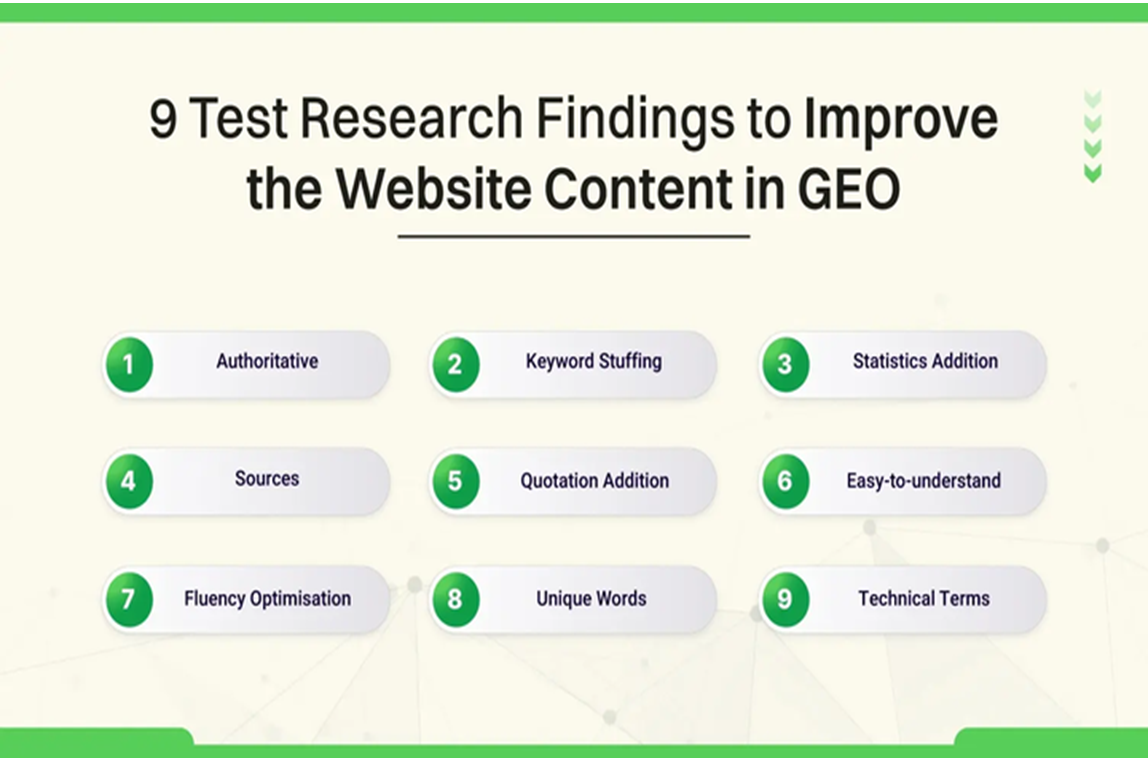
- Authoritative: The content was altered to be more compelling while conveying definitive claims.
- Keyword Stuffing: More keywords were added to match the query.
- Statistics Addition: Instead of a qualitative conversation, quantitative statistics were included.
- Sources: Relevant citations have been added. Like quotes statistics
- Quotation Addition: Quotations from reliable sources have been included.
- Easy-to-understand: Simplified the language.
- Fluency Optimisation: Improved fluency.
- Unique Words: Used in the text whenever possible.
- Technical terms: Technical terms have been incorporated into the content.
The data set for search queries was obtained from Google, Microsoft Bing, and Perplexity. Sources include AI Discover, GPT-4, and others.
So, focus on creating detailed and comprehensive blogs or articles by defining the relation and highlighting the context for deeper meaning. Utilize the various formats for content creation to enrich information and diversify the learning perspective.
Also, update your content with the latest information and trends to maintain regular effectiveness and relevancy in the generative engines.
Conclusion:
In the end, Generative Engine Optimization (GEO) provides a more automated, scalable, and adaptive method of content creation and optimization than traditional Search Engine Optimization (SEO) approaches, which need manual and constant work for the optimization and ranking. Compared to traditional search engines, generative engines give instant and detailed personalized information to users’ queries for improved engagement.
Conventional SEO uses metrics like impression, session duration, and click-through rate (CTR), whereas GEO proposes new metrics to measure the relevance and visibility of citations within generative engine responses, making users eliminate the need to visit individual websites for information as it generates the responses on users queries from the reliable, relevant, and various sources.
AI-powered search optimization is still developing and becoming popular since most users and business owners are using generative AI as their source of information and improved visibility with universally applicable diverse content formats.
MARKETING
How To Develop a Great Creative Brief and Get On-Target Content
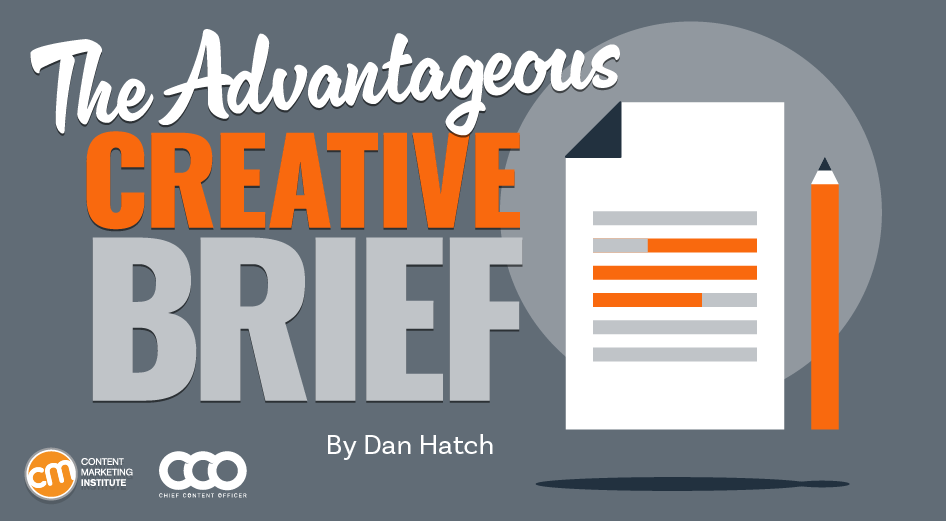
Every editor knows what it feels like to sit exasperated in front of the computer, screaming internally, “It would have been easier if I’d done it myself.”
If your role involves commissioning and approving content, you know that sinking feeling: Ten seconds into reviewing a piece, it’s obvious the creator hasn’t understood (or never bothered to listen to) a damn thing you told them. As you go deeper, your fingertips switch gears from polite tapping to a digital Riverdance as your annoyance spews onto the keyboard. We’ve all been there. It’s why we drink. Or do yoga. Or practice voodoo.
In truth, even your best writer, designer, or audiovisual content creator can turn in a bad job. Maybe they had an off day. Perhaps they rushed to meet a deadline. Or maybe they just didn’t understand the brief.
The first two excuses go to the content creator’s professionalism. You’re allowed to get grumpy about that. But if your content creator didn’t understand the brief, then you, as the editor, are at least partly to blame.
Taking the time to create a thorough but concise brief is the single greatest investment you can make in your work efficiency and sanity. The contrast in emotions when a perfectly constructed piece of content lands in your inbox could not be starker. It’s like the sun has burst through the clouds, someone has released a dozen white doves, and that orchestra that follows you around has started playing the lovely bit from Madame Butterfly — all at once.
Here’s what a good brief does:
- It clearly and concisely sets out your expectations (so be specific).
- It focuses the content creator’s mind on the areas of most importance.
- It encourages the content creator to do a thorough job rather than an “it’ll-do” job.
- It results in more accurate and more effective content (content that hits the mark).
- It saves hours of unnecessary labor and stress in the editing process.
- It can make all the difference between profit and loss.
Arming content creators with a thorough brief gives them the best possible chance of at least creating something fit for purpose — even if it’s not quite how you would have done it. Give them too little information, and there’s almost no hope they’ll deliver what you need.
On the flip side, overloading your content creators with more information than they need can be counterproductive. I know a writer who was given a 65-page sales deck to read as background for a 500-word blog post. Do that, and you risk several things happening:
- It’s not worth the content creator’s time reading it, so they don’t.
- Even if they do read it, you risk them missing out on the key points.
- They’ll charge you a fortune because they’re losing money doing that amount of preparation.
- They’re never going to work with you again.
There’s a balance to strike.
There’s a balance to be struck.
Knowing how to give useful and concise briefs is something I’ve learned the hard way over 20 years as a journalist and editor. What follows is some of what I’ve found works well. Some of this might read like I’m teaching grandma to suck eggs, but I’m surprised how many of these points often get forgotten.
Who is the client?
Provide your content creator with a half- or one-page summary of the business:
- Who it is
- What it does
- Whom it services
- What its story is
- Details about any relevant products and services
Include the elevator pitch and other key messaging so your content creator understands how the company positions itself and what kind of language to weave into the piece.
Who is the audience?
Include a paragraph or two about the intended audience. If a company has more than one audience (for example, a recruitment company might have job candidates and recruiters), then be specific. Even a sentence will do, but don’t leave your content creator guessing. They need to know who the content is for.
What needs to be known?
This is the bit where you tell your content creator what you want them to create. Be sure to include three things:
- The purpose of the piece
- The angle to lead with
- The message the audience should leave with
I find it helps to provide links to relevant background information if you have it available, particularly if the information inspired or contributed to the content idea, rather than rely on content creators to find their own. It can be frustrating when their research doesn’t match or is inferior to your own.
How does the brand communicate?
Include any information the content creators need to ensure that they’re communicating in an authentic voice of the brand.
- Tone of voice: The easiest way to provide guidance on tone of voice is to provide one or two examples that demonstrate it well. It’s much easier for your content creators to mimic a specific example they’ve seen, read, or heard than it is to interpret vague terms like “formal,” “casual,” or “informative but friendly.”
- Style guide: Giving your content creator a style guide can save you a lot of tinkering. This is essential for visuals but also important for written content if you don’t want to spend a lot of time changing “%” to “percent” or uncapitalizing job titles. Summarize the key points or most common errors.
- Examples: Examples aren’t just good for tone of voice; they’re also handy for layout and design to demonstrate how you expect a piece of content to be submitted. This is especially handy if your template includes social media posts, meta descriptions, and so on.
All the elements in a documented brief
Here are nine basic things every single brief requires:
- Title: What are we calling this thing? (A working title is fine so that everyone knows how to refer to this project.)
- Client: Who is it for, and what do they do?
- Deadline: When is the final content due?
- The brief itself: What is the angle, the message, and the editorial purpose of the content? Include here who the audience is.
- Specifications: What is the word count, format, aspect ratio, or run time?
- Submission: How and where should the content be filed? To whom?
- Contact information: Who is the commissioning editor, the client (if appropriate), and the talent?
- Resources: What blogging template, style guide, key messaging, access to image libraries, and other elements are required to create and deliver the content?
- Fee: What is the agreed price/rate? Not everyone includes this in the brief, but it should be included if appropriate.
Depending on your business or the kind of content involved, you might have other important information to include here, too. Put it all in a template and make it the front page of your brief.
Prepare your briefs early
It’s entirely possible you’re reading this, screaming internally, “By the time I’ve done all that, I could have written the damn thing myself.”
But much of this information doesn’t change. Well in advance, you can document the background about a company, its audience, and how it speaks doesn’t change. You can pull all those resources into a one- or two-page document, add some high-quality previous examples, throw in the templates they’ll need, and bam! You’ve created a short, useful briefing package you can provide to any new content creator whenever it is needed. You can do this well ahead of time.
I expect these tips will save you a lot of internal screaming in the future. Not to mention drink, yoga, and voodoo.
This is an update of a January 2019 CCO article.
HANDPICKED RELATED CONTENT:
Cover image by Joseph Kalinowski/Content Marketing Institute
-
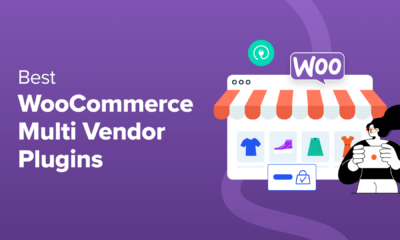
 WORDPRESS7 days ago
WORDPRESS7 days ago9 Best WooCommerce Multi Vendor Plugins (Compared)
-
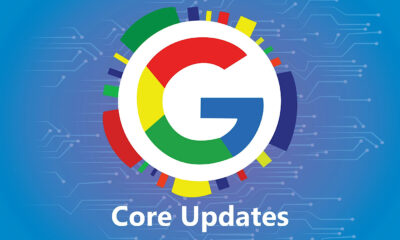
 SEO6 days ago
SEO6 days agoGoogle March 2024 Core Update Officially Completed A Week Ago
-
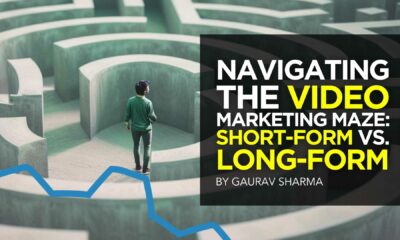
 MARKETING6 days ago
MARKETING6 days agoNavigating the Video Marketing Maze: Short-Form vs. Long-Form
-

 SEARCHENGINES6 days ago
SEARCHENGINES6 days agoGoogle March 2024 Core Update Finished April 19, 2024
-
![The Current State of Google’s Search Generative Experience [What It Means for SEO in 2024] person typing on laptop with](https://articles.entireweb.com/wp-content/uploads/2024/04/The-Current-State-of-Googles-Search-Generative-Experience-What-It.webp-400x240.webp)
![The Current State of Google’s Search Generative Experience [What It Means for SEO in 2024] person typing on laptop with](https://articles.entireweb.com/wp-content/uploads/2024/04/The-Current-State-of-Googles-Search-Generative-Experience-What-It.webp-80x80.webp) MARKETING6 days ago
MARKETING6 days agoThe Current State of Google’s Search Generative Experience [What It Means for SEO in 2024]
-
SEARCHENGINES5 days ago
Daily Search Forum Recap: April 26, 2024
-

 WORDPRESS6 days ago
WORDPRESS6 days agoNew WordPress.com Themes for April 2024 – WordPress.com News
-
SEARCHENGINES3 days ago
Daily Search Forum Recap: April 29, 2024















